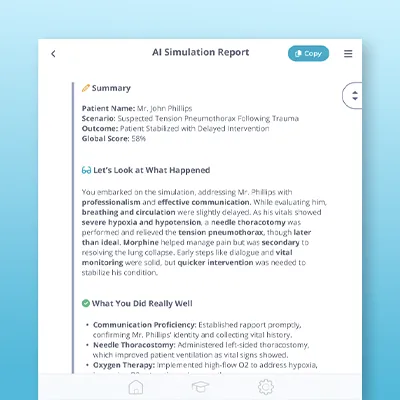Healthcare Simulation Week
at Body Interact
As part of Healthcare Simulation Week by SSH, we thought, “Why not put our new CEO, Silvério Sousa Mendes, to the test?” So, we did just that—challenging him on the real impact of our virtual patient simulator!
We didn’t hold back with the tough questions because we understand how powerful this tool is for training the next generation of healthcare professionals. And we want to ensure you know how we’re actively shaping the future of healthcare education.
Do you believe that virtual patients truly contribute to enhancing the patient care skills of future healthcare professionals? Why?
Absolutely! Virtual patients offer a dynamic and interactive platform that mirrors real-life clinical scenarios. They allow healthcare professionals to practice decision-making, diagnostic skills, and treatment plans in a risk-free environment.
The key advantage of Body Interact virtual simulations is that they provide immediate feedback, which helps learners refine their skills and knowledge continuously. By engaging with diverse scenarios, future healthcare professionals can build a solid foundation of practical experience, which is critical in improving their patient care skills. The ability to repeat scenarios and learn from mistakes without real-world consequences accelerates their learning process and builds confidence.

How does simulation ensure patient safety? Aren’t simulations very different from real patients, particularly in the absence of pain, for example?
Simulation is a vital tool for enhancing patient safety by offering a controlled environment for learners to practice and refine their skills. Although simulations cannot fully replicate the complexities of real patients—such as the subjective experience of pain—they are designed to closely mimic clinical scenarios, including physiological responses and treatment reactions. This controlled practice helps learners build competence and confidence, reducing the risk of errors in actual patient care.
In addition to simulating clinical conditions, modern simulations often incorporate physiological feedback mechanisms, allowing learners to observe and interact with simulated physiological responses. This helps bridge the gap between theoretical knowledge and real-world application. During the Body Interact simulation, the ability to monitor and respond to these physiological cues is crucial for developing a deeper understanding of patient care.
Furthermore, simulations often include detailed debriefing sessions where learners receive feedback and discuss potential safety concerns. These discussions help identify and address issues that could impact patient safety, ultimately leading to improved clinical practices and better patient outcomes. Overall, while simulations may not capture every aspect of real patient interactions, they provide invaluable practice and insight that significantly contribute to enhancing patient safety.
How do you ensure that the simulation of clinical errors is realistic and meaningful, helping students understand the potential consequences of their mistakes?
We take great care to design simulations that reflect a wide range of clinical errors and their potential consequences. This is achieved by collaborating with experienced clinicians and educators who help us create scenarios that accurately represent real-life situations.
Each simulation is crafted to include common mistakes and challenges that healthcare professionals might encounter. By incorporating realistic patient responses and outcomes, learners can see the impact of their decisions and actions. Additionally, post-simulation debriefings are integral to our approach, providing learners with insights into what went wrong and how to avoid similar errors in the future.

Can you share examples of how virtual patient simulations have improved patient outcomes when these skills are applied in clinical settings?
Certainly. There have been numerous instances where the skills honed through virtual patient simulations have translated into improved patient outcomes.
For example, in a recent study, healthcare professionals who regularly used Body Interact virtual simulation tools demonstrated better diagnostic accuracy and quicker intervention times in clinical settings. This improvement was particularly evident in emergency care scenarios where timely decision-making is critical.
In another case, a healthcare facility reported a significant reduction in procedural errors and enhanced team collaboration after incorporating simulation-based training into their continuing education programs. These examples underscore the real-world benefits of simulation training.

The Body Interact team will always support you through any changes and simulation improvements.









